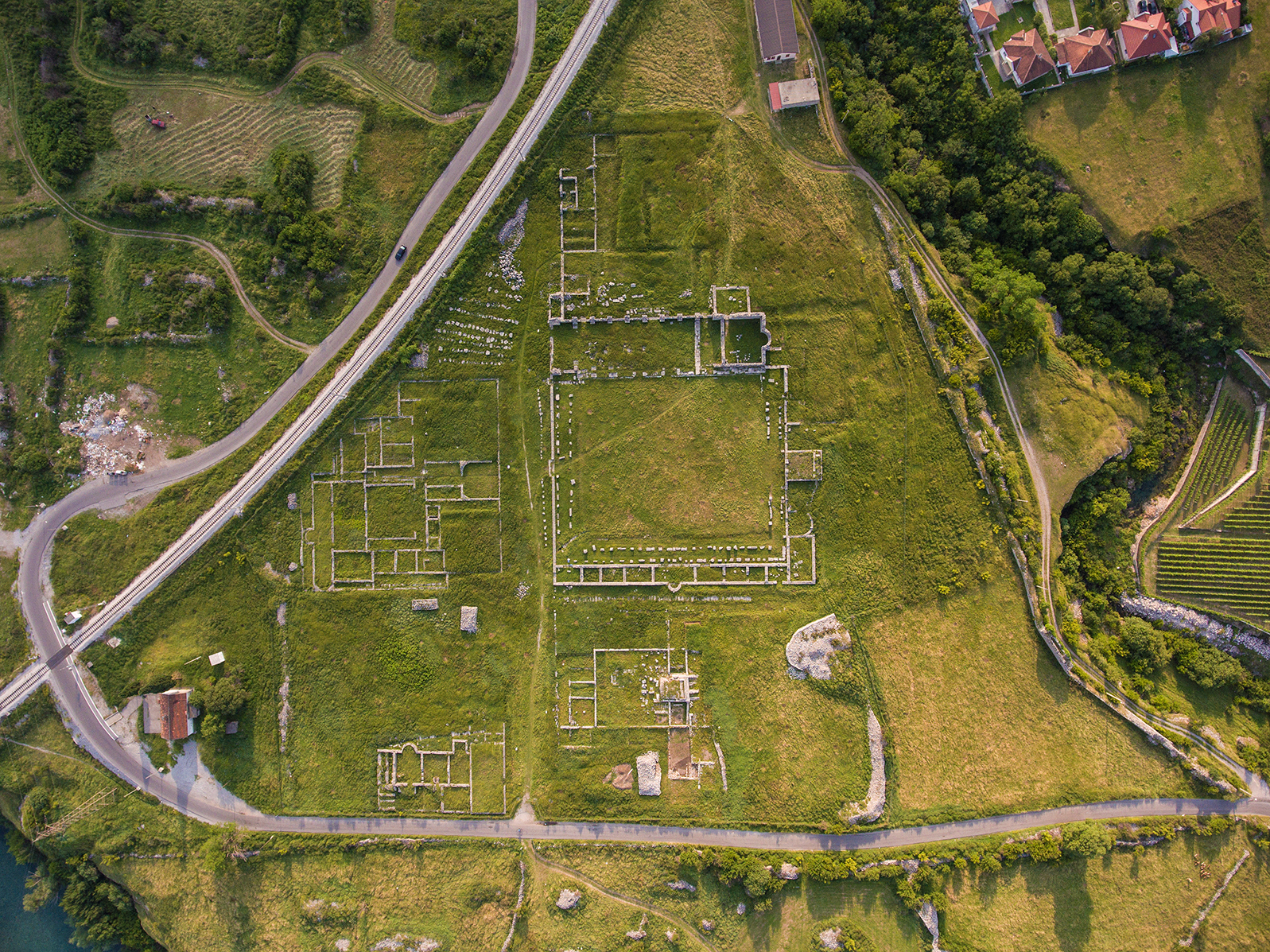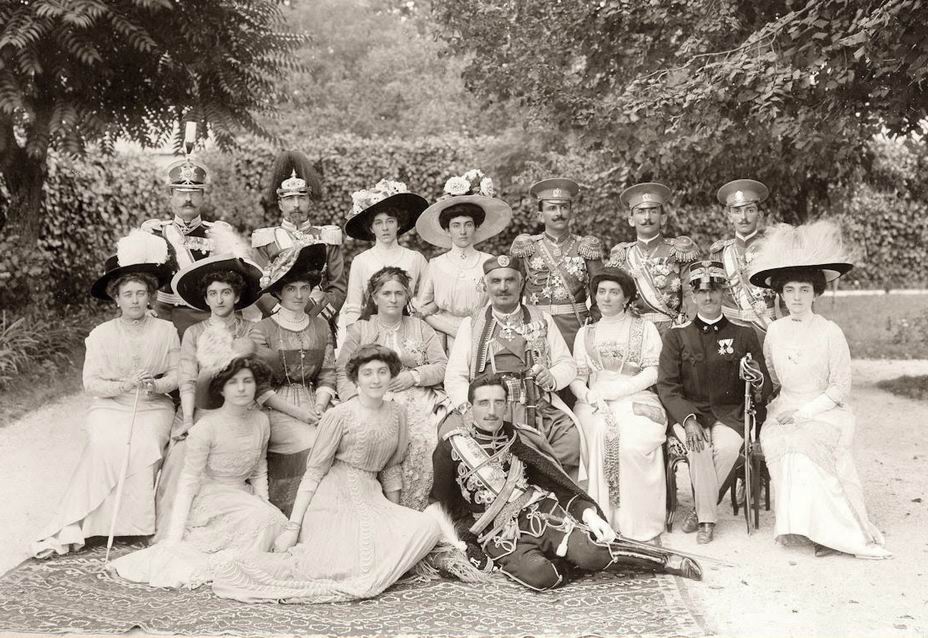|
Tsar's Bridge, Nikšić
The Tsar's Bridge () is a monumental historical bridge near Nikšić, Montenegro. It is a major state-protected landmark despite being not actively used nowadays. Overview The Tsar's Bridge is named after the Russian Emperor Alexander III, who financed the construction of the bridge in the year 1894. It crosses the Zeta river and its valley. It is remarkable for its significant length (270 m) and many spans (18). The highest span measures 13 meters. The bridge is much wider than the modern river channel, this is due to the presence of a large backwater pool that existed in the past, which was drained in the 20th century. Nowadays, the river's channel is straightened and strengthened by concrete in the area, so only one span actually crosses the river. Under the highest bridge span exists a little pedestrian doubling bridge. A local road passes by the bridge, it connects Nikšić to the north and mountainous and rural areas to the south with places such as Pandurica castle ... [...More Info...] [...Related Items...] OR: [Wikipedia] [Google] [Baidu] |
Nikšić
Nikšić (Cyrillic script, Cyrillic: Никшић, ), is the second largest city in Montenegro, with a total population of 32,046 (2023 census) located in the west of the country, in the centre of the spacious Nikšić field at the foot of Trebjesa Hill. It is the center of Nikšić Municipality with population of 65,705 according to 2023 census, which is the largest municipality by area and second most inhabited after Podgorica. It was also the largest municipality by area in the former Yugoslavia. It is an important industrial, cultural, and educational center. Name In classical antiquity, the area of Nikšić was the site of the settlement of the Illyrians, Illyrian tribe of the Endirudini and was known in sources of the time as Anderba or Enderon. The Roman Empire built a Castra, military camp (''castrum Anderba'') in the 4th century AD, which was known as the Ostrogothic fortress ''Anagastum'' (after 459. AD). After Slavic settlement in the region, Anagastum became Slavic ''Ono ... [...More Info...] [...Related Items...] OR: [Wikipedia] [Google] [Baidu] |
Gold Coin
A gold coin is a coin that is made mostly or entirely of gold. Most gold coins minted since 1800 are 90–92% gold (22fineness#Karat, karat), while most of today's gold bullion coins are pure gold, such as the Britannia (coin), Britannia, Canadian Gold Maple Leaf, Canadian Maple Leaf, and American Buffalo (coin), American Buffalo. Alloyed gold coins, like the American Gold Eagle and South African Krugerrand, are typically 91.7% gold by weight, with the remainder being silver and copper. Until about the 1930s, gold coins were Circulation (currency), circulation coins, including Exonumia, coin-like bracteates and Gold dinar, dinars. Since then, gold coins have mainly been produced as bullion coins for Gold as an investment, investors and as commemorative coins for Coin collecting, collectors. While modern gold coins are still legal tender, they are not used in everyday financial transactions, as the metal value invariably exceeds the Real versus nominal value (economics), nominal ... [...More Info...] [...Related Items...] OR: [Wikipedia] [Google] [Baidu] |
Trogir
Trogir () is a historic town and harbour on the Adriatic coast in Split-Dalmatia County, Croatia, with a population of 10,107 (2021) and a total municipal population of 12,393 (2021). The historic part of the city is situated on a small island between the Croatian mainland and the island of Čiovo. It lies west of the city of Split. Since 1997, the historic centre of Trogir has been included in the UNESCO list of World Heritage Sites for its Venetian architecture. History In the 3rd century BC, ''Tragurion'' (Ancient Greek: Τραγύριον, ''Tragyrion'' or Τραγούριον, ''Tragourion'') was founded as a colony by Ancient Greek colonists on the Illyrian coast from the island of Vis, and it developed into a major port until the Roman period. The name comes from the Greek "tragos" (male goat) and "oros" (hill or mountain). Similarly, the name of the neighbouring island of Bua comes from the Ancient Greek "voua" (herd of cattle). The sudden prosperity of Salona ... [...More Info...] [...Related Items...] OR: [Wikipedia] [Google] [Baidu] |
Josip Slade
Josip () is a male given name largely found among Croats and Slovenes, a cognate of Joseph. In Croatia, the name Josip was the second most common masculine given name in the decades up to 1959, and has stayed among the top ten most common ones throughout 2011. Notable people named Josip include: * Ruđer Josip Bošković, Ragusan physicist * Josip Bozanić, Croatian cardinal * Josip Broz Tito, Yugoslav president * Josip Frank, Croatian politician * Josip Globevnik, Slovenian mathematician * Josip Golubar, Croatian footballer * Josip Hatze, Croatian composer * Josip Jelačić, Croatian ban * Josip Katalinski, Bosnian footballer * Josip Kozarac, Croatian writer * Josip Manolić, Croatian politician * Josip Marohnić, Croatian emigrant activist * Josip Plemelj, Slovenian mathematician * Josip Projić, Serbian footballer * Josip Račić, Croatian painter * Josip Skoblar, Croatian former player and football manager * Josip Skoko, Australian soccer player * Josip Juraj Strossmayer, ... [...More Info...] [...Related Items...] OR: [Wikipedia] [Google] [Baidu] |
Podgorica
Podgorica ( cnr-Cyrl, Подгорица; ) is the Capital city, capital and List of cities and towns in Montenegro, largest city of Montenegro. The city is just north of Lake Skadar and close to coastal destinations on the Adriatic Sea. Historically, it was Podgorica's position at the confluence of the Ribnica (Morača), Ribnica and Morača River, Morača rivers and at the meeting-point of the fertile Zeta Plain and Bjelopavlići Valley that encouraged settlement. The surrounding landscape is predominantly mountainous terrain. After World War II, Podgorica was first designated as the capital of Montenegro in 1946. At that time, it was renamed Titograd in honor of Josip Broz Tito, the leader of Yugoslavia. It served as the capital of the Socialist Republic of Montenegro within the Socialist Federal Republic of Yugoslavia until Montenegro's declaration of independence in 2006, after which it was reaffirmed as the capital of an independent Montenegro. The city's original name, Pod ... [...More Info...] [...Related Items...] OR: [Wikipedia] [Google] [Baidu] |
Treaty Of Berlin (1878)
The Treaty of Berlin (formally the Treaty between Austria-Hungary, France, Germany, Great Britain and Ireland, Italy, Russia, and the Ottoman Empire for the Settlement of Affairs in the East) was signed on 13 July 1878. In the aftermath of the Russian Empire, Russian victory against the Ottoman Empire in the Russo-Turkish War of 1877–1878, the European balance of power, major powers restructured the map of the Balkans, Balkan region. They reversed some of the extreme gains claimed by Russia in the preliminary Treaty of San Stefano, but the Ottomans lost their major holdings in Europe. It was one of three major peace agreements in the period after the 1815 Congress of Vienna. It was the final act of the Congress of Berlin (13 June – 13 July 1878) and included the United Kingdom of Great Britain and Ireland, United Kingdom, Austria-Hungary, Third French Republic, France, German Empire, Germany, Kingdom of Italy, Italy, Russia and the Ottoman Empire. Chancellor of Germany Otto vo ... [...More Info...] [...Related Items...] OR: [Wikipedia] [Google] [Baidu] |
Old Herzegovina
Old Herzegovina ( sh-Latn-Cyrl, Stara Hercegovina, Стара Херцеговина) is a historical region, covering the eastern parts of historical Herzegovina, outside the scope of modern Herzegovina. A large section of ''Old Herzegovina'' belongs to modern Montenegro, while a smaller section belongs to the modern Bosnia and Herzegovina and modern Serbia. All of those regions were parts of historical Herzegovina from the middle of the 15th century until 1878. In modern Montenegro, the region includes the municipal areas of Herceg Novi, Nikšić, Pljevlja, Plužine, Šavnik and Žabljak. In modern Bosnia and Herzegovina, the region includes the municipal areas of Čajniče, Foča, Kalinovik and Rudo. In modern Serbia, the region includes the municipal areas of Priboj and Prijepolje. History The region known today as the ''Old Herzegovina'' was part of historical Herzegovina from the middle of 15th century up to the 1878. Initially it was part of the medieval D ... [...More Info...] [...Related Items...] OR: [Wikipedia] [Google] [Baidu] |
Romanov Dynasty
The House of Romanov (also transliterated as Romanoff; , ) was the reigning imperial house of Russia from 1613 to 1917. They achieved prominence after Anastasia Romanovna married Ivan the Terrible, the first crowned tsar of all Russia. Nicholas II, the last Emperor of Russia, and his immediate family were executed in 1918, but there are still living descendants of other members of the imperial house. The house consisted of boyars in Russia (the highest rank in the Russian nobility at the time) under the reigning Rurik dynasty, which became extinct upon the death of Feodor I in 1598. The Time of Troubles, caused by the resulting succession crisis, saw several pretenders and imposters lay claim to the Russian throne during the Polish-Lithuanian occupation. On 21 February 1613, the Zemsky Sobor elected Michael Romanov as tsar, establishing the Romanovs as Russia's second reigning dynasty. Michael's grandson, Peter I, who took the title of emperor and proclaimed th ... [...More Info...] [...Related Items...] OR: [Wikipedia] [Google] [Baidu] |
Nikola I Petrović-Njegoš
Nikola I Petrović-Njegoš ( sr-Cyrl, Никола I Петровић-Његош; – 1 March 1921) was the last monarch of Montenegro from 1860 to 1918, reigning as prince from 1860 to 1910 and as the country's first and only king from 1910 to 1918. His grandsons were kings Alexander I of Yugoslavia and Umberto II of Italy, among others. Biography Early life Nikola was born in the village of Njeguši, the home of the reigning House of Petrović. He was the son of Mirko Petrović-Njegoš, a celebrated Montenegrin warrior (an elder brother to Danilo I of Montenegro) and his wife, Anastasija Martinovich (1824–1895). After 1696, when the dignity of vladika, or prince-bishop, became hereditary in the Petrović family, the sovereign power had descended from uncle to nephew, the vladikas belonging to the order of the black clergy (i.e., monastic clergy) who are forbidden to marry. A change was introduced by Danilo I, who declined the episcopal office, married and converted Monte ... [...More Info...] [...Related Items...] OR: [Wikipedia] [Google] [Baidu] |
Nikšić–Podgorica Railway
The Nikšić–Podgorica railway is a railway connecting Montenegro's capital Podgorica and the country's second largest city, Nikšić. The line connects to the Belgrade–Bar railway and the Podgorica–Shkodër railway at Podgorica. It is operated by ŽICG. Overview Nikšić–Podgorica is a standard-gauge railway. It passes through 12 tunnels of total length of , and across nine bridges (overall length of ), mostly following the Bjelopavlići plain along its corridor. The speeds on this line are between . The line has five stations (Nikšić, Ostrog, Danilovgrad, Spuž and Podgorica) and seven halts. History The line was built as a narrow gauge railway in 1948. It was connected to the preexisting ''Nikšić–Bileća line''. In 1965, the line was upgraded to standard gauge. The extension to Bileća was decommissioned in 1976. The railway has primarily been used for transport of bauxite ore from the Nikšić mine to the Podgorica Aluminium Plant. Chronic lack of ... [...More Info...] [...Related Items...] OR: [Wikipedia] [Google] [Baidu] |
Montenegro
, image_flag = Flag of Montenegro.svg , image_coat = Coat of arms of Montenegro.svg , coa_size = 80 , national_motto = , national_anthem = () , image_map = Europe-Montenegro.svg , map_caption = , image_map2 = , capital = Podgorica , coordinates = , largest_city = capital , official_languages = Montenegrin language, Montenegrin , languages2_type = Languages in official use , languages2 = , ethnic_groups = , ethnic_groups_ref = , ethnic_groups_year = 2023 census , religion = , religion_ref = , religion_year = 2023 census , demonym = Montenegrins, Montenegrin , government_type = Unitary parliamentary republic , leader_title1 = President of Montenegro, President , leader_name1 = Jakov Milatović , leader_title2 ... [...More Info...] [...Related Items...] OR: [Wikipedia] [Google] [Baidu] |




